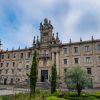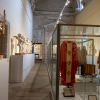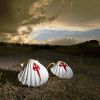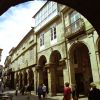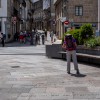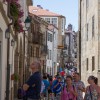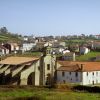- Accede I
- Regístrate I
- carrito
07. Monasterio de San Martiño Pinario
07. Monasterio de San Martiño Pinario
Galería de imágenes

Estamos frente a la fachada del imponente monasterio de San Martín Pinario. Fue fundado en el siglo X para albergar a un grupo de monjes cuya tarea era custodiar las reliquias del Apóstol. Con una extensión de más de veinte mil metros cuadrados, es el segundo mayor de España, sólo superado por El Escorial.
Su esplendor comienza cuando en 1494 pasa a depender de la congregación benedictina de Valladolid. Poseedor de rentas y propiedades en toda Galicia, llegó a ser el más importante monasterio de la Compostela medieval, con la mayor biblioteca de toda Galicia y uno de los mayores albergues del país. Su riqueza era tal, que en el siglo XVIII repartía limosna regularmente a unos 800 pobres de la ciudad, un día a los hombres y otro día a las mujeres, turnándose con el arzobispado, que hacía lo mismo en días alternos. Fue tal el poder alcanzado en sus tiempos por la orden benedictina, que llegó a competir con la propia Catedral hasta su supresión en 1837.
El edificio actual muestra una fachada barroca que fue rematada en 1738. El nicho central acoge a San Benito, fundador de la orden, mientras que sobre el escudo de Carlos I puede verse la imagen ecuestre del santo titular, San Martín de Tours, que parte su capa con un pobre.
Hoy en día, el edifico monacal alberga el Seminario Mayor, algunas aulas de la universidad compostelana, así como una hospedería de uso turístico. Pero alrededor de sus claustros interiores de los siglos XVII y XVIII, existen colecciones visitables y algunas de sus salas se utilizan también como espacios expositivos. La visita a la iglesia y al Museo Diocesano permite, además, admirar algunos de los mejores retablos del Barroco español, así como la antigua sillería coral de madera que ocupaba parte de la nave central de la Catedral.








